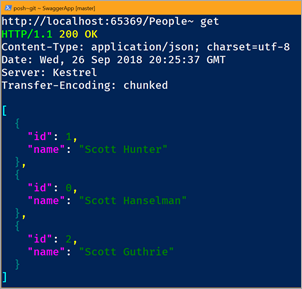A command-line REPL for RESTful HTTP Services
 My that's a lot of acronyms. REPL means "Read Evaluate Print Loop." You know how you can run "python" and then just type 2+2 and get answer? That's a type of REPL.
My that's a lot of acronyms. REPL means "Read Evaluate Print Loop." You know how you can run "python" and then just type 2+2 and get answer? That's a type of REPL.
The ASP.NET Core team is building a REPL that lets you explore and interact with your RESTful services. Ideally your services will have Swagger/OpenAPI available that describes the service. Right now this Http-REPL is just being developed and they're aiming to release it as a .NET Core Global Tool in .NET Core 2.2.
You can install global tools like this:
dotnet tool install -g nyancat
Then you can run "nyancat." Get a list of installed tools like this:
C:\Users\scott> dotnet tool list -g Package Id Version Commands -------------------------------------------------------------------- altcover.global 3.5.560 altcover dotnet-depends 0.1.0 dotnet-depends dotnet-httprepl 2.2.0-preview3-35304 dotnet-httprepl dotnet-outdated 2.0.0 dotnet-outdated dotnet-search 1.0.0 dotnet-search dotnet-serve 1.0.0 dotnet-serve git-status-cli 1.0.0 git-status github-issues-cli 1.0.0 ghi nukeeper 0.7.2 NuKeeper nyancat 1.0.0 nyancat project2015to2017.cli 1.8.1 csproj-to-2017
For the HTTP-REPL, since it's not yet released you have to point the Tool Feed to a daily build location, so do this:
dotnet tool install -g --version 2.2.0-* --add-source https://dotnet.myget.org/F/dotnet-core/api/v3/index.json dotnet-httprepl
Then run it with "dotnet httprepl." I'd like another name? What do you think? RESTy? POSTr? API Test? API View?
Here's an example run where I start up a Web API.
C:\SwaggerApp> dotnet httprepl
(Disconnected)~ set base http://localhost:65369
Using swagger metadata from http://localhost:65369/swagger/v1/swagger.json
http://localhost:65369/~ dir
. []
People [get|post]
Values [get|post]
http://localhost:65369/~ cd People
/People [get|post]
http://localhost:65369/People~ dir
. [get|post]
.. []
{id} [get]
http://localhost:65369/People~ get
HTTP/1.1 200 OK
Content-Type: application/json; charset=utf-8
Date: Wed, 26 Sep 2018 20:25:37 GMT
Server: Kestrel
Transfer-Encoding: chunked
[
{
"id": 1,
"name": "Scott Hunter"
},
{
"id": 0,
"name": "Scott Hanselman"
},
{
"id": 2,
"name": "Scott Guthrie"
}
]
Take a moment and read that. It can be a little confusing. It's not HTTPie, it's not Curl, but it's also not PostMan. it's something that you run and stay running if you're a command line person and enjoy that space. It's as if you "cd (change directory)" and "mount" a disk into your Web API.
You can use all the HTTP Verbs, and when POSTing you can set a default text editor and it will launch the editor with the JSON written for you! Give it a try!
A few gotchas/known issues:
- You'll want to set a default Content-Type Header for your session. I think this should be default.
- set header Content-Type application/json
- If the HTTP REPL doesn't automatically detect your Swagger/OpenAPI endpoint, you'll need to set it manually:
- set base https://yourapi/api/v1/
- set swagger https://yourapi/swagger.json
- I haven't figure out how to get it to use VS Code as its default editor. Likely because "code.exe" isn't a thing. (It uses a batch .cmd file, which the HTTP REPL would need to special case). For now, use an editor that's an EXE and point the HTTP REPL like this:
- pref set editor.command.default 'c:\notepad2.exe'
I'm really enjoy this idea. I'm curious how you find it and how you'd see it being used. Sound off in the comments.
Sponsor: Rider 2018.2 is here! Publishing to IIS, Docker support in the debugger, built-in spell checking, MacBook Touch Bar support, full C# 7.3 support, advanced Unity support, and more.
About Scott
Scott Hanselman is a former professor, former Chief Architect in finance, now speaker, consultant, father, diabetic, and Microsoft employee. He is a failed stand-up comic, a cornrower, and a book author.
About Newsletter
It's as if you "cd (change directory)" and "mount" a disk into your Web API.
Imagine actually mounting the Web API to some directory/mount point with a FUSE driver built on this … 🤔
It is located at \AppData\Local\Programs\Microsoft VS Code and you can just put the full path after `code.exe`
Simple Hierarchy in PowerShell (SHiPS) - [ https://github.com/PowerShell/SHiPS ]
Here's the opening description:
A PowerShell provider allows any data store to be exposed like a file system as if it were a mounted drive. In other words, the data in your data store can be treated like files and directories so that a user can navigate data via cd or dir. SHiPS is a PowerShell provider. To be more precise it's a provider utility that simplifies developing PowerShell providers.
I'm not advocating to go with one or the other, but I did find it interesting and thought it would be advantageous for the two teams to work together on the Http REPL.
then you could list out the rel links and follow them. You could do things like "self", "next", "prev", "first", "last" and navigate automatically.
Comments are closed.
